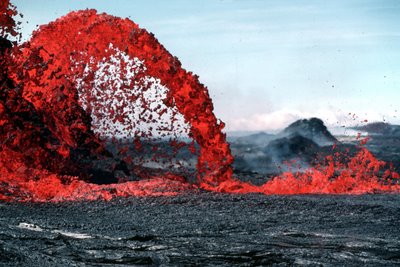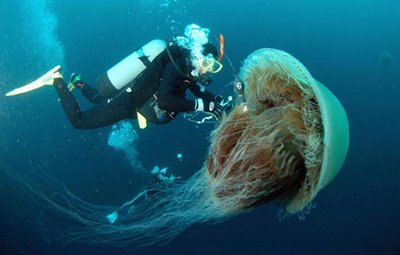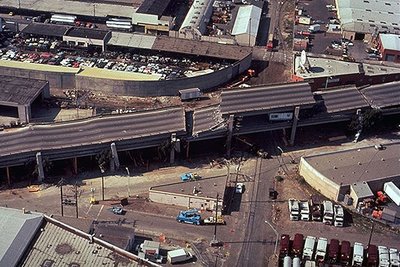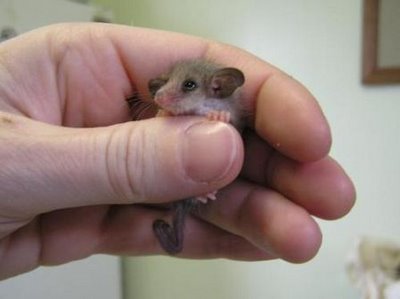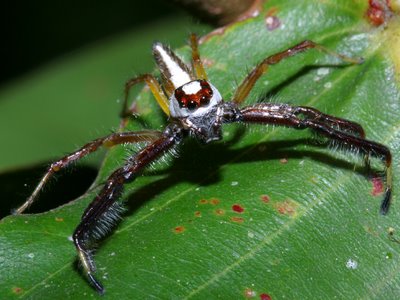 Spiders are ancient animals with a history going back many millions of years. They have always been with us, an ancient source of fear and fascination. They are abundant and widespread and are natural controllers of insect populations. Wherever you live, you're always close to a spider.
Spiders are ancient animals with a history going back many millions of years. They have always been with us, an ancient source of fear and fascination. They are abundant and widespread and are natural controllers of insect populations. Wherever you live, you're always close to a spider. Spiders are arachnids not insects, but both spiders and insects belong to the largest group of animals on Earth, the arthropods - animals with hard external skeletons and jointed limbs (greek arthro = joint, podos = footed).
Spiders are arachnids not insects, but both spiders and insects belong to the largest group of animals on Earth, the arthropods - animals with hard external skeletons and jointed limbs (greek arthro = joint, podos = footed).
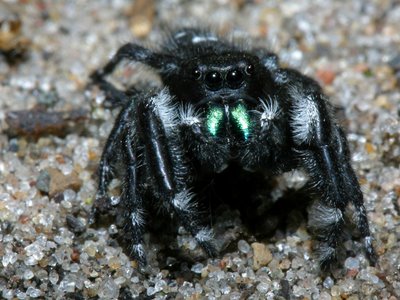 A few spiders are so small and live such hidden lives that most of us never see them. Others are enormous. Some of the smallest spiders in the world are anapid spiders, sometimes called armoured spiders because of the cuticular plates on their pinhead-sized bodies. Small spiders like anapids are usually found in damp, cool habitats like forest leaf litter and moss because their small bodies can lose water rapidly in dryer conditions. The largest spiders in the world include the South American Goliath Tarantula, some so big their legs can span a dinner plate. Such spiders may take decades to reach such a size. However, spider size is limited, partly because their respiratory physiology becomes less efficient at very large sizes.
A few spiders are so small and live such hidden lives that most of us never see them. Others are enormous. Some of the smallest spiders in the world are anapid spiders, sometimes called armoured spiders because of the cuticular plates on their pinhead-sized bodies. Small spiders like anapids are usually found in damp, cool habitats like forest leaf litter and moss because their small bodies can lose water rapidly in dryer conditions. The largest spiders in the world include the South American Goliath Tarantula, some so big their legs can span a dinner plate. Such spiders may take decades to reach such a size. However, spider size is limited, partly because their respiratory physiology becomes less efficient at very large sizes.
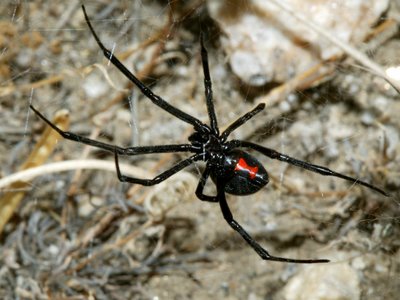 Spiders were among the earliest animals to live on land. Despite this their fossil record is relatively poor. They probably evolved about 400 million years ago from thick-waisted arachnid ancestors that were not long emerged from life in water. The first definite spiders, thin-waisted arachnids with abdominal segmentation and silk producing spinnerets, are known from fossils like Attercopus fimbriungus. This spider lived 380 million years ago during the Devonian Period, more than 150 million years before the dinosaurs.
Spiders were among the earliest animals to live on land. Despite this their fossil record is relatively poor. They probably evolved about 400 million years ago from thick-waisted arachnid ancestors that were not long emerged from life in water. The first definite spiders, thin-waisted arachnids with abdominal segmentation and silk producing spinnerets, are known from fossils like Attercopus fimbriungus. This spider lived 380 million years ago during the Devonian Period, more than 150 million years before the dinosaurs.
 Most of the early segmented fossil spiders belonged to the Mesothelae, a group of primitive spiders with the spinnerets placed underneath the middle of the abdomen (rather than at the end as in 'modern' spiders). They were probably ground dwelling predators, living in the giant clubmoss and fern forests of the mid-late Palaeozoic, where they were presumably predators of other primitive arthropods (like cockroaches, giant silverfish, slaters and millipedes). Silk may have been used simply as a protective covering for the eggs, a lining for a retreat hole, and later perhaps for simple ground sheet web and trapdoor construction.
Most of the early segmented fossil spiders belonged to the Mesothelae, a group of primitive spiders with the spinnerets placed underneath the middle of the abdomen (rather than at the end as in 'modern' spiders). They were probably ground dwelling predators, living in the giant clubmoss and fern forests of the mid-late Palaeozoic, where they were presumably predators of other primitive arthropods (like cockroaches, giant silverfish, slaters and millipedes). Silk may have been used simply as a protective covering for the eggs, a lining for a retreat hole, and later perhaps for simple ground sheet web and trapdoor construction.
 As plant and insect life diversified so also did the spider's use of silk. Spiders with spinnerets at the end of the abdomen (Opisthothelae) appeared more than 250 million years ago, presumably promoting the development of more elaborate sheet and maze webs for prey capture both on ground and foliage, as well as the development of the safety dragline.
As plant and insect life diversified so also did the spider's use of silk. Spiders with spinnerets at the end of the abdomen (Opisthothelae) appeared more than 250 million years ago, presumably promoting the development of more elaborate sheet and maze webs for prey capture both on ground and foliage, as well as the development of the safety dragline.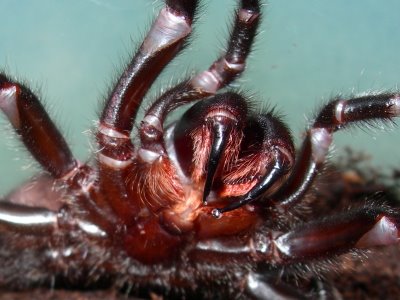
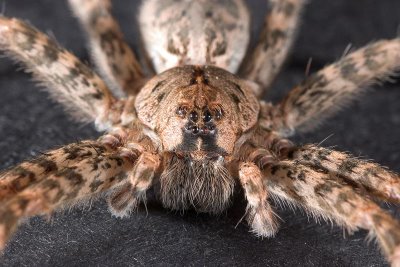

 A 300 million year old, half metre long, fossil arachnid, Megarachne servinei, was originally described as a spider, but is now thought more likely to represent another type of spider-like ancient arachnid. Its unique features include the enormous size, massive shovel-like jaws and ribbed, shield-like covering over the abdomen. An arachnid of this size must have fed on large prey like cockroaches and giant millipedes. But why did this massive predator need such an impressively armoured body - were there even bigger arachnid predators about?
A 300 million year old, half metre long, fossil arachnid, Megarachne servinei, was originally described as a spider, but is now thought more likely to represent another type of spider-like ancient arachnid. Its unique features include the enormous size, massive shovel-like jaws and ribbed, shield-like covering over the abdomen. An arachnid of this size must have fed on large prey like cockroaches and giant millipedes. But why did this massive predator need such an impressively armoured body - were there even bigger arachnid predators about?





